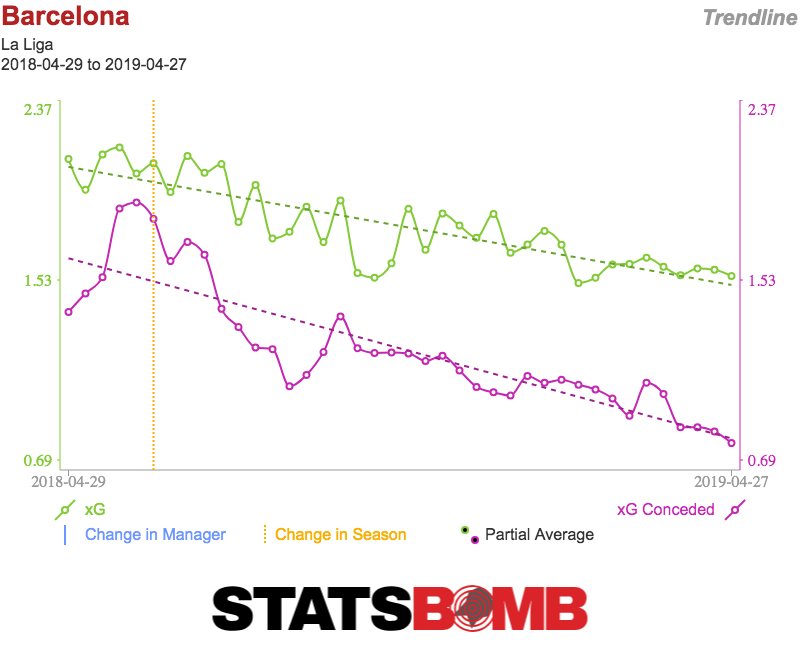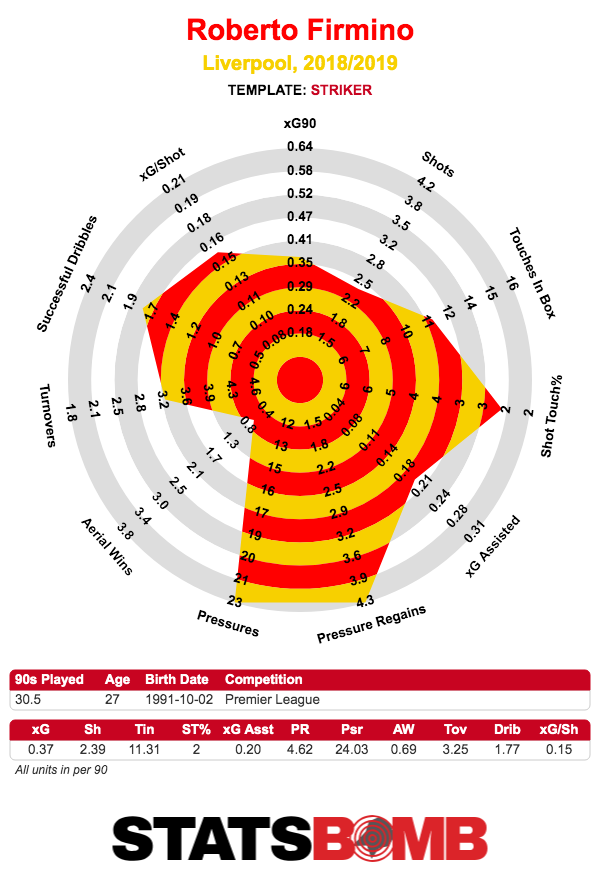Barcelona against Liverpool is the kind of encounter that just a few years ago would have felt like David against Goliath but now seems, in theory at least, finely balanced. FiveThirtyEight have this fixture as tight as it could possibly be, with Liverpool favoured to go through 51% of the time, and while the bookmakers are somewhat more sold on Barcelona (SkyBet has the Catalans at an implied probability of 60% to reach the final), only the most ardent of Blaugranes would expect this to be a cakewalk. They could be right, of course, as anything can happen, but most are expecting a close fought encounter, so let’s take a closer look at what we might see over these two games.
The Season So Far
Barcelona once again won the La Liga title largely in cruise control. Real Madrid’s implosion and Atletico seemingly reaching their ceiling meant that Ernesto Valverde’s team merely had to be good enough, and that is what they have been. Looking at the numbers, Barcelona remain the best side in La Liga, but not quite at the heights we’ve seen in the past. The team are generating 1.70 expected goals per game, the most in the division, but down a notch from last season’s 1.96. The defence, meanwhile, hasn’t seen much of a change (0.99 xG conceded per game this year against 1.01 last time), but this isn’t much to shout about when it puts them as merely the 8th best team in La Liga on that side of the ball. Things have shaken out as largely the same in the Champions League, putting up an xG difference per game of 0.77 in this competition compared to 0.71 in the league. We’re still talking about one of the best sides in Europe here, but things aren’t quite what they once were.
Barca’s most potent attacking weapon is, well, you already know the answer to that question. First in xG per 90. First in xG assisted. First in xGChain. First in deep progressions. First in passes into the box. First in sponsorship deals with unhealthy junk food and soft drinks he certainly never touches. First in appearances on video game covers. No, it’s not Rafinha.

Almost exactly 50% of Barca’s expected goals this season have been taken or assisted by Lionel Messi, and that doesn’t even account for all the ball progression work he does before we get to the shot or the assist. As much as this team have issues elsewhere, Messi has once again been electric. This is very much necessary, as the club’s other key attackers are having somewhat down years. Luis Suarez has seen a 25% decrease in his expected goals and assists per 90 this season. Whether this is merely a disappointing year or the beginning of a terminal decline for the 32 year old remains to be seen. Still, there remains a strong understanding between Suarez and Messi, even as the former is the junior partner more than ever before. The same cannot be said of Philippe Coutinho. After flirting with a deeper role, the Brazilian has generally been fielded on the left of the front three, nominally the position where he played his best football for Liverpool. In those final 18 months where he really shone on Merseyside, however, his playmaking skills were emphasised, while Sadio Mane and later Mohamed Salah offered pace running in behind on the opposite flank. At Barca, the task for a wide player is totally different, with the need being to offer an outlet without the ball while Messi takes a ball dominant role. This is an awkward fit, and one he has only somewhat adapted to.

The team has not been static over the course of the season, and clear adjustments have been made along the way. Seemingly accepting that Marc-Andre ter Stegen is merely human, Valverde’s side have become more cautious as the year has gone on. When looking at the xG trendlines, there’s a very obvious move towards a declining attack met with an improving defence. Things are slowly tightening up.

The change here has been in the quality of shots faced. Since the winter break, the model estimates that the shots Barca have conceded are 10% less likely to be scored than those before Christmas. With the volume of shots conceded largely static, this quality difference has led to 0.15 fewer expected goals conceded per game. Valverde has improved his side’s biggest hole, even if it has come at a cost to the attacking end.
As for Liverpool, the story has been largely about maintaining a high level of performance across the season. The team’s xG difference per game of 0.98 lags somewhat behind Manchester City’s, but still puts them far and away ahead of every other team in the Premier League and, while you can’t really compare two different leagues on such a like for like basis, ahead of Barcelona. Jurgen Klopp’s team is, to put it simply, really good.
After a midseason flirtation with a 4-2-3-1 shape, the tried and trusted 4-3-3 has returned in recent months to good effect. This revolves around Roberto Firmino nominally leading the line and the press but frequently dropping into deeper positions to allow the narrowly positioned wide players, Salah and Mane, to attack the space he vacates and get on the end of chances. In the absence of width from the forward line, full backs Andy Robertson and Trent Alexander-Arnold have been positioned especially high, and crossing from these players has become an important part of Liverpool’s attack.
The compromise has come in the form of the side’s rather functional midfield. The current preferred trio of Fabinho, Jordan Henderson and Naby Keita are all performing relatively well, with Keita especially beginning to shine, but with the extent to which the full backs push up the pitch, there seems to be something of a reluctance to allow the midfield to focus on anything but hard work and solidity. This passmap in the most recent league fixture against Huddersfield Town illustrates the set up, with the central midfield trio not averaging touches any higher up the pitch than the fullbacks.

The emphasis on a functional midfield trio leaves the side without much in the way of a creative passing threat in central areas. Keita has started to offer more of a threat in this regard, but as part of an impressive all round game rather than being a specialist at it. This means that Liverpool lack traditional playmaking qualities in the centre of the pitch, and instead have to rely on two attacking threats: the aforementioned crossing from fullbacks, and counter-pressing situations in the opposition half. Klopp is famous for his claim that a counter-pressing system is the best playmaker in the world, and he’s taken it quite literally here. Fortunately for him, he’s coached a side extremely adept at creating these chances, with pressure in the correct moments a huge part of how Liverpool attack. Liverpool are not, unlike some top sides, a team that usually press to the opposition goalkeeper (though it has happened on a few occasions), but hit at specific moments, in specifically worked scenarios. It used to be that the way to counter this was to defend deep and narrow, but the increased use of the full backs in wide areas has made this more difficult.
The front three are without doubt the main attraction. Salah had a difficult patch in February and March, but this was the exception, and his form in April saw him return to previous heights. Mane has scored a number of goals and continues to do so in important moments, even if the extent to which this is repeatable is unclear. His 20 league goals from an xG of 14.27 is quite the return, though the underlying numbers are still strong. Firmino might be the most important element, though. His ability to lead a press from the striker position is perhaps unrivaled in European football, and his understanding with Salah and Mane is so strong that these frequently turn into goal scoring opportunities. That everyone in the world has accepted the Liverpool striker doesn’t have to score 25 goals a season is a testament to everything else he does. There are some questions over whether he will be fit to start the first leg of the tie, and this could have a huge impact on the game.

So How Will They Match Up?
Jurgen Klopp has approached big games this season in a number of different ways, so it’s not obvious what to expect. The likeliest scenario might be that Liverpool attempt to attack almost exclusively in moments of transition, avoiding much possession and looking to press Barcelona while unsettled, launching quickly into counter attacks. Considering the combination of Barca’s status as a relatively (though not outrageously) high pressing side and a number of ageing, increasingly slow players such as Gerard Pique and Sergio Busquets, there is a decent chance that this could cause some problems. Add in the importance of left back Jordi Alba as an attacking cog and the script for some defensive issues writes itself. Whether Firmino is fit to start is an important question, though it may not change Liverpool’s approach significantly. If he is unavailable, the most likely scenario is Mane moving to the centre forward role while Divock Origi plays on the left, continuing the counter-pressing style, albeit at a lesser ability.
At the other end, this may be a game for Liverpool’s fullbacks to be somewhat more conservative than usual. Messi obviously is a threat everywhere, and that he’s nominally attacking one of Liverpool’s strongest links between Robertson and Van Dijk might not necessarily have a huge impact. The other side might be less of a concern. As much as Alexander-Arnold has suffered defensive issues, it has generally been against fast players who want to run in behind, so Coutinho may be the ideal opponent for him. It’s a simplistic conclusion, but it feels like this tie will be decided by how much Barca are able to involve Messi. For now, though, the smart money might be on a relatively close fought affair tonight, leaving things wide open for the second leg at Anfield. Unless you are reading this after the game has been played and you are laughing at how completely and utterly wrong I was.
Should be a cracker.
Header image courtesy of the Press Association
